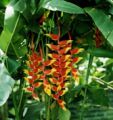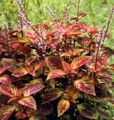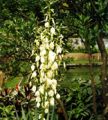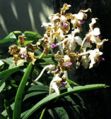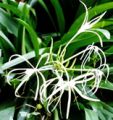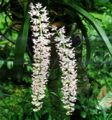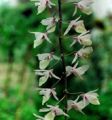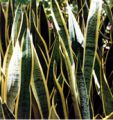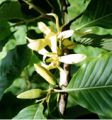Ornamental Plants
Ornamental Plants plants that are grown for their aesthetic look, with no particular concern for their utility, although some may possess both of these attributes; mainly include higher plant groups such as ferns, gymnosperms and angiosperms. Common ornamental plants seen in homes and gardens and along the sides of roads and highways in Bangladesh are mostly angiosperms, but some ferns and gymnosperms are also seen in small numbers. Following are the common ornamental plants of Bangladesh:
-
Hanging lobster claw
-
Coleus
-
Yucca
-
Vanda
-
Spider lily
-
Rhynchostylis
-
Dendrobium
-
Mother-in-law’s tongue
-
Golden champa
Garden and house plants Shapla (National Flower of Bangladesh, Water lily), Nymphaea pubescens; Garden croton, Croton variegatum; Coleus, Coleus blumei; Copper leaf, Acalypha wilkesiana; Zebrina, Zebrina pendula; Purple heart, Setcreasea purparea; Monstera, Monstera deliciosa; Caladium, Caladium hortulanum; Cabbage palm, Cordyline terminalis; Mother-in-law's tongue, Sansevieria trifascita; Maiden hair fern, Adiantum capillus; Bleeding heart, Clerodendrum thomosonae; Ixora, Ixora coccinea; Pentas, Pentas lanceola; China rose, Hibiscus rosa-sinensis; Spider plant, Chlorophytum comosum 'variegatum'; Aloe, Aloe vera; Poinsettia, Euphorbia pulcherrima; Brilliant star, Kalachoe pinnnata; Dracena, Dracena marginata; Peace lily, Spathiphyllum walliseii; Money plant, Rhahidophora aurea; Heart leaf, Scindapsus aureus; Crystal antherium, Anthurium cystallinum; Flamingo lily, Anthurium andreanum; Four-o-clock plant, Mirabilis jalapa; Crossandra, Crossandra undulaefolia; Shrimp plant, Beloperone guttata; Silver king, Aglaonema commutatum; Guzamias, Guzamania lingulata; Bird of paradise, Strelitzia reginae; Lobster claw, Helicnia rostrata; Hanging lobster claw, Heliconia rostrata; Gardenia, Gardenia jasminoides; Aluminium plant, Pilea cadierei; Alocasia, Alocasia lowii; Pellionia, Pellionia pulchra; Bird's nest fern, Asplenium nidus; Spider lily, Hymenocalis littoralis; Bagan Bilash (Bougan-villea, Bouganvillea species); Rangoon creeper, Quisqualis indica; Yucca, Yucca gloriosa; Vanda, Vanda tessellata; Rhynchostylis, Rhynchostylis retusa.
Avenue tree Yellow oleander, Thevetia peruviana; Fish tail palm, Caryota urens; Royal palm, Roystonia regia; Beef-wood tree, Casuarina equisetifolia; 'Peepul' tree, Ficus religiosa; Golden champa, Michelia champaca; Flame of the forest, Butea monosperma; Indian laburnum, Cassia fistula; Gold mohur tree, Delonix regia; Ashoka tree, Saraca asoca; Purple, Bauhinia purpurea; Bauhinia, Raintree, Samanea saman; Silk tree, Albizzia lebbek; 'Neem' tree, Melia azadirachta; Red silk cotton tree, Bombax ceiba; Indian almond, Terminalia catappa; 'Kodom', Anthocephalus chinensis; Chatim (Devil's tree, Alstonia scholaris); Nageshwar (Iron wood, Masua ferrea); Debdaru (Must tree, Polyalthia longifolia); Hasna-Hena (Queen of the night, Cestrum nocturnum); Kamini (Chinese Box, Murraya paniculata); Eucalyptus, Eucalyptus species; Shefali (Tree of sorrow, Nyctanthes arbortistis); Hijal (Indian oak, Barringtonia acutangula).
About a dozen varieties of orchids are commonly seen at homes, but altogether there are over 150 species so far recorded in Bangladesh of which about 100 are epiphytic (growing on trees) and 50 terrestrial. Among the gymnosperms, cycas, thuja and needle pine are seen in home gardens. [Zia Uddin Ahmed]
Pests of ornamental plant Several dozens of ornamental plants grow as seasonal, annual or perennial herbs, shrubs, and trees in Bangladesh. In the past, ornamentals were considered as of aesthetic importance only in the country. But, recently many of them achieved significant economic and commercial importance. Numerous insect and mite species attack rhizomes, root, stem, leaves, shoots, buds, flowers, fruits and seeds of ornamentals and causes immense damage. Despite their manifold importance, no systematic research efforts were made for the qualitative or quantitative improvement of the ornamental plants in Bangladesh. As such, published basic information, such as listing of pests for each ornamental plant species is not available.
Among the annual and perennial ornamental herbs and shrubs that grow in Bangladesh, Allamanda, Begonia, Bauhinia, Beumonti, Bocconia (plum poppy), Bougainvillea, cacti, Carnation, Cherry, China Box, Camphire, Candytuft, Calendula, Chandnee, Croton, Dog rose, Gardenia, Ivy, Ixora, Jasmine, Lily, Rangoon cruper, etc are more common. Among these, available information on insect or mite pests are limited to some plant species only.
Over a dozen of insect species are reported to attack roses, Rosa species in the country. Two species of aphids, Macrosiphum euphorbiae and M. rosae, rose thrips, Thrips fuscipennis and red spider mite, Tetranychus urticae suck sap from leaves, flower buds and petals and cause distorted and deformed flowers. Citrus whitefly, Aleurocanthus spiniferus and an unidentified scale insect, Icerya sucks leaf saps and causes stunting growth. Several chaffers beetle, Adorectus bicolor, A. bicundatus, A. lasiopygus and Oxycetonia versicolor feed on leaves or flowers. Caterpillars of Pandemis heparana and Archips oporana roll leaves and feed inside. Recently, whitefly species, the spiralling whitefly, Aleurodicus dispersus has emerged as a serious pest of several ornamental shrubs, particularly, the madhabilata, Hiptage benghalensis. Both adults and nymphs suck sap from leaves and deposits honey dew that serves as a growth media for sooty mould, which in turn affects photosynthesis of the plant. Affected leaves are defoliated and plant is stunted. Several mealy bug species are found to attack many perennial ornamental shrubs, particularly, crotons, (Codioeum species), ixora, (Ixora species), gardenia (Gardenia jasminoides), china rose, (Hibiscus rosa-chinensis), etc, in gardens as well as in indoors (potted plants) and cause defoliation.
Among the seasonal ornamental herbs that grow in the country, aster amaranths, balsam, chrysanthemum, caladium, celosia, cosmos, dahlia, dianthus, daisy, hollyhock, marigold, phlox, petunia, poppy, poinsettia, tuberose, etc are more common. Important insect or mite pests include the following:
Aphids, Myzus persicae and M. euphobiae attack snapdragon, Antirrhinum species. Both adults and nymphs suck sap from stem and cause stem distortion and stunting of growth. Tarnished plant bug, Lygus ragulipennis and the aphid, M. euphobiae are reported to attack aster (Callistephus chinensis). Both adults and nymphs suck saps from leaves, shoots and flower buds and cause stunted growth, twisted shoots and malformed flowers. Okra (Lady's finger) aphids, Aphis fabae sucks saps from young shoots and leaves of dahlia (Dahlia imperialis). Caterpillars of Phlogophora meticulosa, Progonia partonalis and Nymphula responsalis feed on flowers.
Potato aphids, M. persicae attack shoots of carnation (Dianthus caryophyllus). Adult weevil, Otiorrhynchus sulcatus attacks young shoots and buds of camellia (Camellia japonica). A whitefly, Aleyrodes azaleae sucks sap from azalea leaves, deposits honey dew which causes infection of sooty moulds. Chrysanthemum aphid, Macrosiphoniella sanborni sucks leaf and flower saps, while a earwig, Forficula species is reported to feed on flower petals of chrysanthemum. Larvae of delphinium moth, Polychrisia moneta feed on leaves, buds and flowers of Delphinium. Three species of pest insects are reported from gladiolus. Of these aphid, M. euphorbiae and gladiolus thrips, Thrips simplex suck saps, while caterpillars of P. meticulosa eat flower petals. Of the two reported pests of lilies, lily aphid, Dysaphis tulipae sucks saps from bulbs, while the lily beetle, Lilioceris lilii feeds on leaves. Among the two pests of phlox, aphid, M. persicae sucks leaf-saps; the stem and bud nematode, Ditylenchus dipsaci feeds on leaf as well as on stems. Of the two reported pests of zinnia, tarnished plant bug, L. regulipennis sucks saps from leaves, shoots and flower buds, and the leaf nematodes, Aphelenchoids ritzema-bosi feed on leaves causing blotching. [M Ibrahim Ali]

